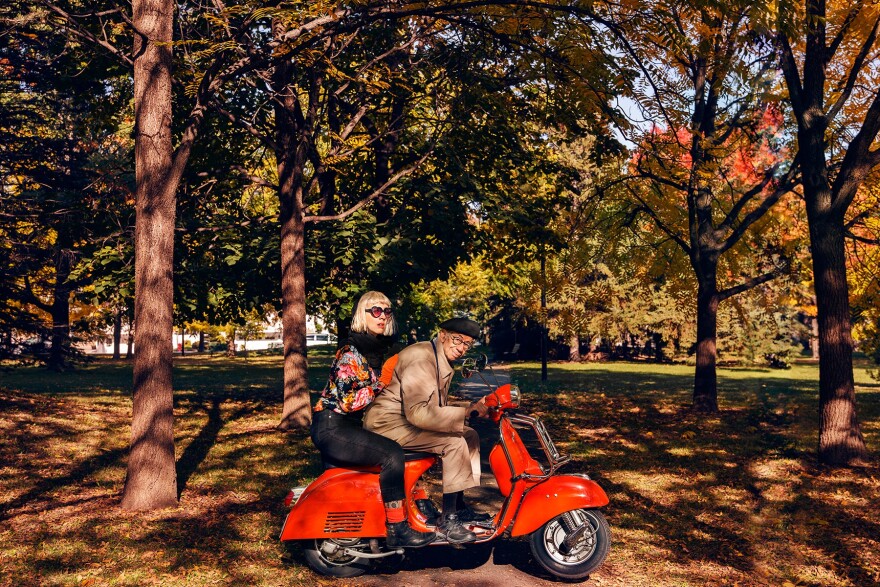For years, Made Here has brought local and regional documentaries to 开云体育鈥檚 Main television channel. They air at 8 pm each Thursday, and now, you can also stream them on our website. Here in the 18th season, we鈥檙e providing more context on each film by bringing you interviews with the directors or subjects.
This week鈥檚 film is called Gabor, and it recounts the life of 95-year-old , who has been based in Montreal since the late 1950s.
The documentary bills itself as a 鈥渜uirky, feel-good portrait鈥� of a giant of Canadian contemporary photography. It鈥檚 also an immigrant story that offers more than one lesson on how to age with elegance over animus.
The film was written and directed by Montreal-based
开云体育's Jenn Jarecki sat down with Joannie Lafreni猫re to discuss Gabor. Their conversation below has been edited and condensed for clarity.
Jenn Jarecki: For those listeners who may not know of Gabor Szilasi, who is he? Will you tell us a little bit about him?
Joannie Lafreni猫re: Yes, with pleasure. So Gabor is from Hungary. So he arrive in Quebec in 1957 after the insurrection in Hungary. So he arrive with his dad, and he already start photographing in Hungary. But it was his job when he arrive in Quebec. So he first start doing photography in 鈥� like, it's not the NFB, National Film Board of Canada, but kind of 鈥� so he start photographing there for many years. And he became quite famous in Quebec. So start doing rural photography. Like, he immortalized a lot of not only landscape but mostly people. And after that, he became like, yeah, he became an important person in contemporary Canadian art.

So I discover him when I was studying photography in 2007. He got a retrospective exhibition in Joliette, so in Quebec. And I didn't know him before, and I was really [blown away] by his photography, by the art of his image, like the poetry in it, the humor, the dignity, the respect. I really, really, really loved it. And I told myself, when I will be an adult, I will be a photographer.
Jenn Jarecki: How did Gabor's approach to photography influence the way you shot this documentary about him?
Joannie Lafreni猫re: When I start thinking about the film, I was sure that I don't want people from the museum, I don't want these people to talk about the importance of the art of Gabor. I decide that we gonna meet people and follow Gabor on how he is doing all his photography. What is his magic touch?
So we follow him on different situations. So we get back on different rural place where we've already been. Like in the 70s. And we saw him encounter people, and it was very, very moving for me, how he dance with people, how he interact with them, and how he is curious about them. But people are also very curious about him.
Jenn Jarecki: The film is really playful, and it's also really smile-inducing, you know, until it isn't. Can you talk about how you chose to represent Gabor's proximity to the Holocaust as a Jewish-born Hungarian during World War II?
Joannie Lafreni猫re: It was quite tough because Gabor is really optimist, joyful. But under this, there is 鈥� there is all this tough family situation that he was in through the Second World War. And it took him some time to talk to me about it. And it was some time, "I think we should talk about my mum." And maybe the next time I saw him, he said, "Oh, no, I think we should 鈥� we should not talk about it." And I was like, "Yeah, I think we definitely need to talk about it. But it says so much about you and how you decide to stay optimist."
His path was tough and painful. And the last interview that we did together, I arrive at his home and he said, "OK, I'm ready. I wrote a letter. I wanna start with that." And I was like, "Oh, OK, let's do that." And, for me, it was a good point to open up a discussion. And that's how we decide to put it in the film.

Jenn Jarecki: Joannie, I'm hoping that I can play a little bit of audio from one of the interviews you had with Gabor. And I'm wondering if you can translate it for us and then talk about its significance.
Joannie Lafreni猫re: Yes.
"Pour moi, la photographie c'est un po猫me. Mais la vid茅o, le cin茅ma, c'est un roman."Gabor Szilasi
So yeah, that's a lovely moment. The poetry of Gabor. So in this moment, Gabor talk to me about how he describe and he compare photography and cinema. So for him, photography, it's more like a poem. And cinema is more like a novel. So I found that really powerful.
Jenn Jarecki: Joannie, why do you think Gabor's work has been so well-received for so long?
Joannie Lafreni猫re: Yeah, I think it's, there is different answer to that. His work is really powerful, I think, because for people who don't know his work, when they discover it, it's like they feel seen, or they feel it could be them. And in his poetry, is very luminous also, is very light-full.
And also, because Gabor, as we show in the film, is an amazing human being. So it's not only his work, it his work talking about him also. So it's, it's quite an in-between. And I think there was a good timing for him also. And the fact that he's an immigrant and the way you look through his new home. There's many, many factor, but he's an amazing photographer and a wonderful human being.
Gabor premieres on 开云体育's main TV channel on Thursday, Nov. 16 at 8:00 p.m.



